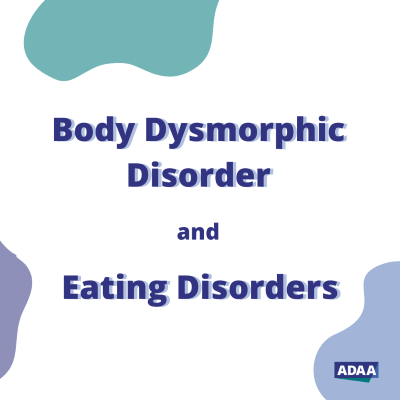Body Dysmorphic Disorder and Eating Disorders: Overlapping Presentations, Differing Treatments.
Body Dysmorphic Disorder and Eating Disorders: Overlapping Presentations, Differing Treatments.

There can be confusion when differentiating between body dysmorphic disorder (BDD) and eating disorders (EDs). BDD involves obsessive thoughts, repetitive behaviours, and mental acts in response to perceived appearance flaws. Eating disorders involve disturbances in thoughts and behaviours related to eating, weight, and shape (in Anorexia Nervosa, Bulimia Nervosa, and OSFED) (APA, 2022).
Similarities
BDD and EDs involve pre-occupying appearance-related thoughts and repetitive behaviours, an appearance-oriented self-evaluation, and comparable emotions. Similar personality characteristics (perfectionism, obsessive-compulsiveness, rejection sensitivity, introversion, & neuroticism) are seen (Fisher, Neziroglu, & Feusner, 2023), as are the comorbidities of OCD, depression, substance abuse, anxiety, and low self-esteem (Angelakis, Gooding, & Panagioti, 2016). Other likenesses include teen onset (typically), chronicity, high mortality rates, poor insight, and visual perceptual disturbances (Grant, Leppink, & Redden, 2017).
What Differentiates EDs?
An ED diagnosis requires a disturbance in eating in attempt to control body weight/shape such as: dietary restriction, fasting, bingeing and purging, or rumination. Weight can be (but is not always) affected. Whilst BDD and EDs can involve dietary restriction, BDD rarely involves these other behaviours related to eating. In BDD behaviours are usually focused on perceived defects of the face/head (skin, hair, nose). In EDs the focus is on food, weight, and shape (particularly stomach, hips, and legs), with an intense fear of weight gain. This differing focus can lead to similar behaviours (e.g., excessive grooming, mirror use, body checking, excessive exercise), but in EDs can also lead to weight loss, purging, laxative/diuretic use, and rituals around eating. There is risk of serious medical complications in EDs (Grant et al., 2017) and EDs tend to be more “ego syntonic” than BDD.
I find these questions useful in in my practice:
|
1. Is food intake restricted or eating impaired? Why? |
|
2. Is there an intense fear of weight gain/becoming “fat”? |
|
3. Where is the appearance preoccupation primarily focused? |
|
4. Are there other weight/shape-control behaviours such as purging and laxative use? |
|
5. Has there been a change in weight? Why? |
|
6. Are their medical complications? |
Clients with BDD can have a focus on body fat or weight (Grant et al., 2017). I tend to consider an additional ED diagnosis if there is disturbed eating, intense preoccupation with overall body weight/shape, and other disordered eating-related behaviours such as purging or laxative use.
Treatment
CBT (with ERP) and SSRI’s are first-line treatments for BDD (NICE, 2005). CBT, Specialist Supportive Clinical Management (SSCM), Maudsley Model of Anorexia Nervosa Treatment for Adults (MANTRA), guided self-help, Family Based Treatment, and Adolescent Focused Therapy are evidence-based treatments for EDs (NICE, 2017). For EDs, the chosen treatment modality is determined by research evidence, clinical expertise, and patient values, preferences, and characteristics (Sackett et al., 1996), and may address cognitions, behaviours, emotional regulation, interpersonal relationships, temperament, biological factors, developmental tasks, and sense of identity. Treatment involves medical monitoring, a multi-disciplinary team (therapist, dietitian, GP, psychiatrist, paediatrician), and family involvement (NICE, 2013).
There are similarities in the CBT treatment of BDD and EDs including: motivational interviewing, addressing self-evaluation, reducing compulsive behaviours, exposure therapy, and behavioural experiments. Differences include a focus on addressing eating and weight-control behaviours, collaborative weighing, reducing binges, developing emotional regulation skills, and weight restoration (if needed). Also, CBT for BDD addresses perceptual retraining and other specific symptoms (e.g., cosmetic surgery seeking) (Wilhelm, Phillips, & Steketee , 2013).
How do we proceed when BDD and EDs co-occur? The only suggestion I have found in the scientific literature, is that treatment would be more intensive and longer (Grant et al., 2017). I typically proceed by collaborating with the client around which condition is the most clinically and medically concerning. This often results in targeting the ED first given the medical risks (especially when low weight, purging, fasting, or excessive exercise are present). Nutritional restoration often reduces preoccupation, which may benefit both disorders. Given overlap in self-evaluation and appearance-related repetitive behaviours, it may be possible to treat these symptoms simultaneously, but only if medical risk has been mitigated, and likely only if CBT is the treatment for both disorders.
This post is presented in collaboration with ADAA's OCD and Related Disorders SIG. Learn more about the SIG.
References
American Psychiatric Association (APA). (2022). Diagnostic and statistical manual of mental disorders (5th ed., text rev.). https://doi.org/10.1176/appi.books.9780890425787
Angelakis, I., Gooding, P.A., & Panagioti, M. (2016). Suicidality in body dysmorphic disorder (BDD): A systematic review with meta-analysis. Clinical Psycholgy Review, 49, 55-66. https://doi.org/10.1016/j.xpe.2016.08.002
Fisher, E., Neziroglu, F., & Feusner, J. (2023, Summer). Eating disorders are not the same as body dysmorphic disorder (and why it matters). OCD Newsletter, 37(2. https://iocdf.org/download/summer-2023-vol-37-num-2/
Grant, J. E., Leppink, E. W., & Redden, S.A. (2017). The Relationship Between Body Dysmorphic Disorder and Eating Disorders. In K.A. Phillips (Ed.), Body dysmorphic disorder: Advances in research and clinical practice (pp. 503-513). New York: Oxford University Press.
National Institute for Health and Care Excellence. (2005). Obsessive-compulsive disorder and body dysmorphic disorder: treatment. [NICE Guideline NO. 31]. https://www.nice.org.uk/guidance/cg31
National Institute for Health and Care Excellence, (2017). Eating disorders: recognition and treatment. [NICE Guideline No. 69]. https://www.nice.org.uk/guidance/ng69
Sackett, D.L., Rosenberg, W. M., Gray, J.A., Haynes, R.B., & Richardson, W.S. (1996). Evidence based medicine: what it is and what it isn’t. BMJ, Vol 312 (7023): 71–73.
Wilhelm, S., Phillips, K.A., Steketee, G (2013). Cognitive-Behavioural Therapy for Body Dysmorphic Disorder. The Guilford Press, New York.
















